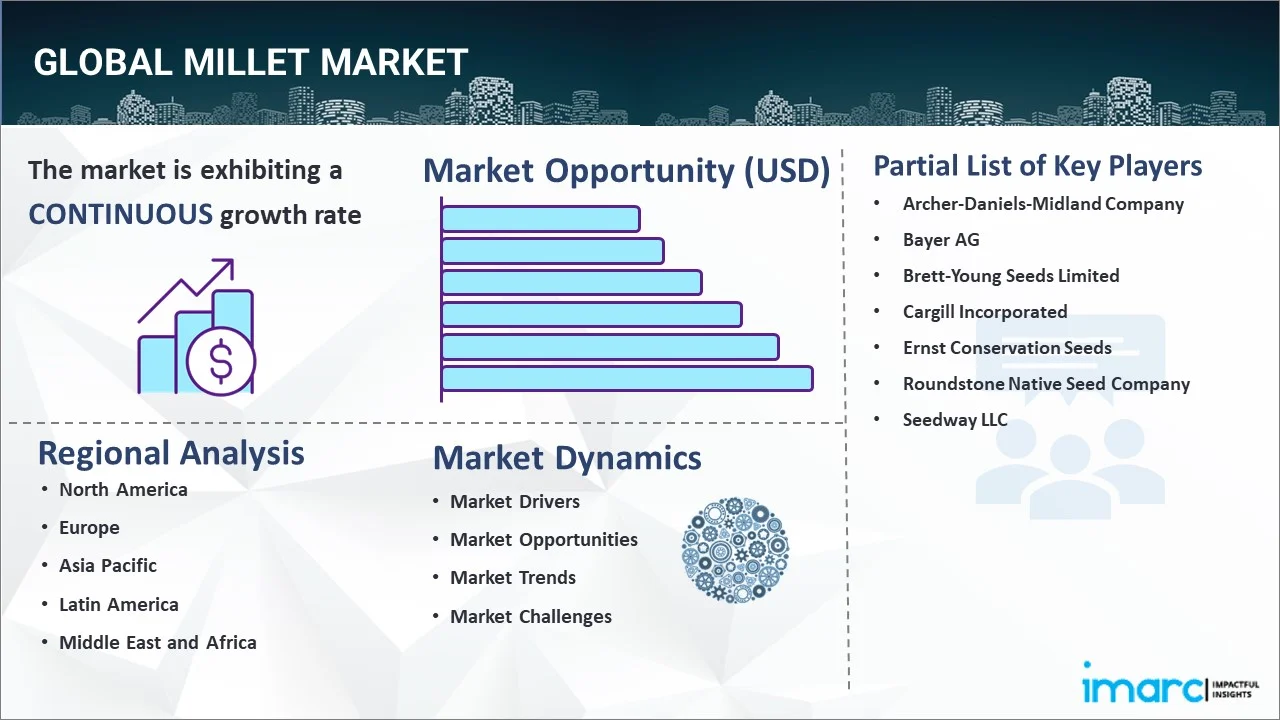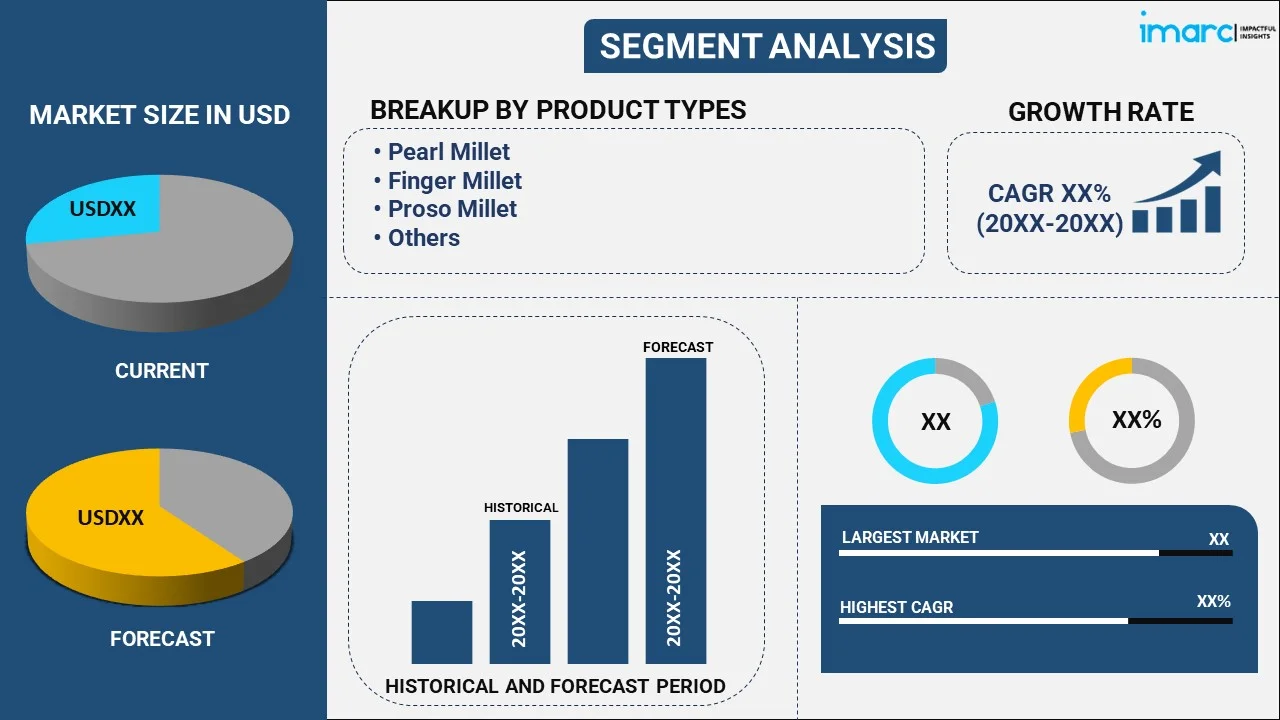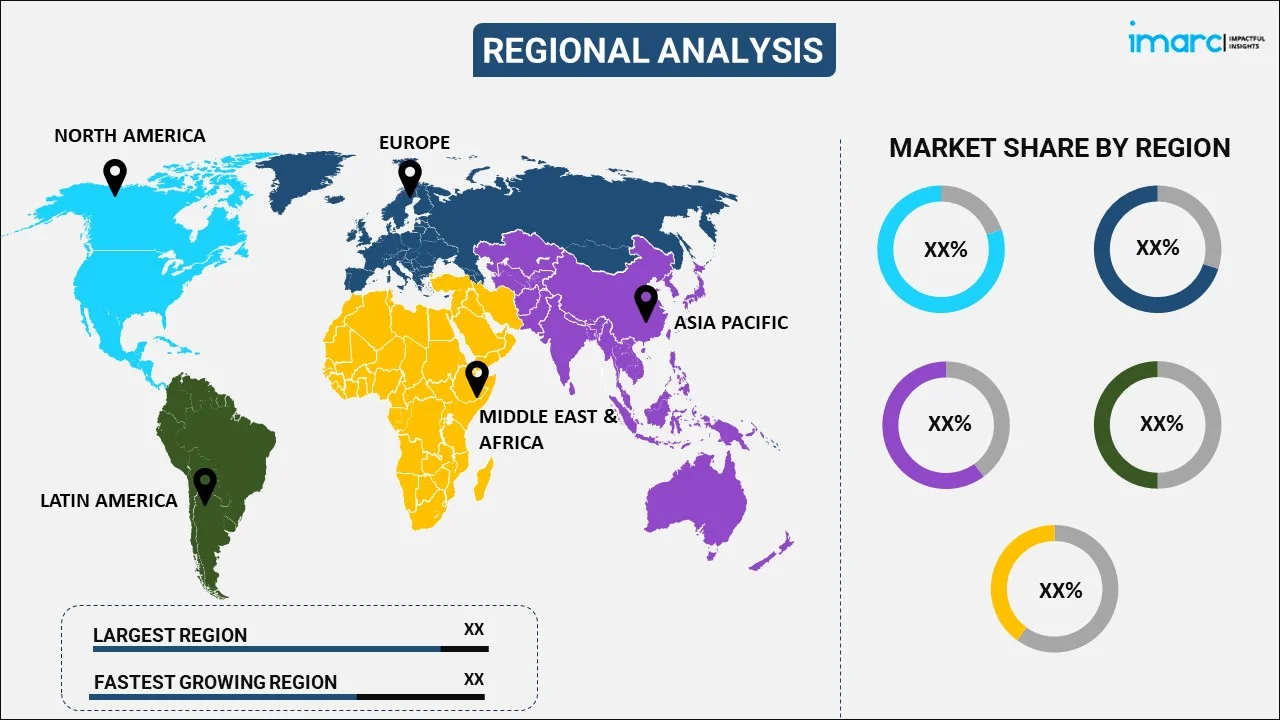
Millet Market Report by Product Type (Pearl Millet, Finger Millet, Proso Millet, and Others), Application (Infant Food, Bakery Products, Beverages, and Others), Distribution Channel (Supermarket and Hypermarkets, Traditional Grocery Stores, Online Stores, and Others), and Region 2025-2033
Millet Market Size:
The global millet market size reached USD 13.4 Billion in 2024. Looking forward, IMARC Group expects the market to reach USD 19.4 Billion by 2033, exhibiting a growth rate (CAGR) of 3.93% during 2025-2033. The increasing government support, rising demand for sustainable and healthy food options, growing export demand for millet, and significant expansion of organic and sustainable farming are the major factors propelling the market growth.
|
Report Attribute
|
Key Statistics
|
|---|---|
|
Base Year
|
2024
|
|
Forecast Years
|
2025-2033
|
|
Historical Years
|
2019-2024
|
|
Market Size in 2024
|
USD 13.4 Billion |
|
Market Forecast in 2033
|
USD 19.4 Billion |
| Market Growth Rate 2025-2033 | 3.93% |
Millets refer to the small-seeded grasses that yield cereal grains and are cultivated globally in semi-arid regions. They are rugged crops that can flourish in adverse soil and water-scarce environments, making them a sustainable crop choice for dry, semi-arid, and sub-humid agricultural areas with diverse climates. Millets can be utilized in a wide range of dishes, such as porridges, bread, soups, stews, and beer, and are also used as a source of animal feed, particularly for poultry and livestock. Due to their high fiber, protein, vitamin, and mineral content, gluten-free and hypoglycemic properties, millets are suitable for people with gluten intolerance or celiac disease. In addition, they also offer several health advantages, including improved digestion, decreased cholesterol levels, and better control of blood sugar levels. Furthermore, millets are more cost-effective compared to other cereal grains, making them an ideal option for individuals on a tight budget, thus influencing the millet market growth.

Millet Market Trends:
Government Initiatives Promoting Millet Cultivation
Government initiatives aimed at promoting millet cultivation are playing a crucial role in the growth of the millet market, particularly in regions such as Asia and Africa. Policies that focus on enhancing food security, such as the United Nations (UN) General Assembly designated 2023 as the International Year of Millets (IYM 2023), with the FAO leading the celebration in partnership with other key stakeholders. It has significantly boosted awareness, production, and the importance of millets in addressing global food security challenges. These initiatives encourage farmers to grow more millet by providing financial incentives, access to improved seeds, and technical support. As a result, millet production has expanded, meeting domestic consumption needs and international export demands. The promotion of millets as a climate-resilient and nutrient-rich crop has also attracted interest from policymakers, contributing to long-term market growth.
Rising Export Demand for Millets
The increasing global demand for millet, particularly from health-conscious consumers and regions focusing on sustainable diets, is another major driver of the millet market. According to the Agricultural and Processed Food Products Export Development Authority (APEDA), exports of millets and related products from India reached a total of 169,049.11 MT, with a value of Rs. 608.12 crore ($75.45 million USD) in the fiscal year 2022-2023. Additionally, millets are versatile, nutritious, and gluten-free, making them a popular choice among consumers seeking healthier and more sustainable food options. As more countries and consumers embrace sustainable agricultural practices and dietary habits, the demand for millet is expected to grow further, encouraging small-scale and large-scale farmers to increase production for the export market, which is creating new opportunities for millet producers globally.
Organic and Sustainable Farming Growth
The global shift toward organic farming and sustainable agricultural practices is significantly contributing to the growth of the millet market. As more consumers demand organic and eco-friendly food products, millets, which require fewer chemical inputs compared to other grains, are becoming a preferred crop in organic farming systems. According to the Research Institute of Organic Agriculture, organic farming is conducted across 188 countries, involving over 96 million hectares of farmland under organic management by approximately 4.5 million farmers. In 2022, the global sales of organic food and beverages approached 135 Billion euros. Moreover, millets' adaptability to organic farming practices, coupled with their resilience to drought and low soil fertility, makes them an ideal crop for farmers looking to transition to sustainable agriculture. As per the millet market analysis, the demand for organic products continues to increase, and more farmers are likely to adopt millet cultivation, further driving market growth and expanding the reach of millets in domestic and international markets across the globe.
Millet Market Segmentation:
IMARC Group provides an analysis of the key trends in each segment of the global millet market, along with forecasts at the global, regional, and country levels from 2025-2033. Our report has categorized the market based on product type, application and distribution channel.
Product Type Insights:

- Pearl Millet
- Finger Millet
- Proso Millet
- Others
The report has provided a detailed breakup and analysis of the millet market based on the product type. This includes pearl millet, finger millet, proso millet, and others. According to the report, pearl millet represented the largest segment.
Application Insights:
- Infant Food
- Bakery Products
- Beverages
- Others
The report has provided a detailed breakup and analysis of the millet market based on the application. This includes infant food, bakery products, beverages, and others. According to the report, infant food represented the largest segment.
Distribution Channel Insights:
- Supermarket and Hypermarkets
- Traditional Grocery Stores
- Online Stores
- Others
A detailed breakup and analysis of the millet market based on the distribution channel has also been provided in the report. This includes supermarket and hypermarkets, traditional grocery stores, online stores, and others. According to the report, traditional grocery stores accounted for the largest market share.
Regional Insights:

- North America
- United States
- Canada
- Europe
- Germany
- France
- United Kingdom
- Italy
- Spain
- Others
- Asia Pacific
- China
- Japan
- India
- South Korea
- Australia
- Indonesia
- Others
- Latin America
- Brazil
- Mexico
- Others
- Middle East and Africa
The report has also provided a comprehensive analysis of all the major regional markets, which include North America (the United States and Canada); Europe (Germany, France, the United Kingdom, Italy, Spain, Russia, and others); Asia Pacific (China, Japan, India, South Korea, Australia, Indonesia, and others); Latin America (Brazil, Mexico, and others); and the Middle East and Africa. According to the report, Asia Pacific was the largest regional market for millet. Some of the factors driving the Asia Pacific millet market included considerable growth in the agriculture industry, rising sales of millet-based snack foods, easy product availability across online and offline retail channels, etc.
Competitive Landscape:
The report has also provided a comprehensive analysis of the competitive landscape in the global millet market. Competitive analysis such as market structure, market share by key players, player positioning, top winning strategies, competitive dashboard, and company evaluation quadrant has been covered in the report. Also, detailed profiles of all major companies have been provided. Some of the companies covered include:
- Archer-Daniels-Midland Company
- Bayer AG
- Brett-Young Seeds Limited
- Cargill Incorporated
- Ernst Conservation Seeds
- Roundstone Native Seed Company
- Seedway LLC
Kindly note that this only represents a partial list of companies, and the complete list has been provided in the report.
Millet Market News:
- In September 2024, McDonald's India (West & South), managed by Westlife Foodworld, has teamed up with CSIR-Central Food Technological Research Institute (CFTRI) to launch a new multi-millet bun, announced during National Nutrition Week. This collaboration leverages CFTRI’s scientific expertise and McDonald’s commitment to nutritious offerings. The bun features a blend of five nutrient-dense millets Bajra, Ragi, Jowar, Proso, and Kodo sourced from various parts of India, enhancing its nutritional value with essential vitamins, minerals, and dietary fiber.
- On 25 January 2023, ITC introduced mission millet by integrating its agriculture, food, and hospitality divisions to strongly promote millet. The company plans to expand its assortment of millet-based items, introducing new products such as millet noodles, pasta, dosa and idli mixes, ragi vermicelli, and a variety of millet-based cookies, confectioneries, and snacks. Through its mission millet, ITC aims to raise awareness about millet, strengthen millet supply chains, and introduce advanced technology to create appealing and flavorful millet-based foods.
Millet Market Report Scope:
| Report Features | Details |
|---|---|
| Base Year of the Analysis | 2024 |
| Historical Period | 2019-2024 |
| Forecast Period | 2025-2033 |
| Units | Billion USD |
| Scope of the Report | Exploration of Historical Trends and Market Outlook, Industry Catalysts and Challenges, Segment-Wise Historical and Future Market Assessment:
|
| Product Types Covered | Pearl Millet, Finger Millet, Proso Millet, Others |
| Applications Covered | Infant Food, Bakery Products, Beverages, Others |
| Distribution Channels Covered | Supermarket and Hypermarkets, Traditional Grocery Stores, Online Stores, Others |
| Regions Covered | Asia Pacific, Europe, North America, Latin America, Middle East and Africa |
| Countries Covered | United States, Canada, Germany, France, United Kingdom, Italy, Spain, China, Japan, India, South Korea, Australia, Indonesia, Brazil, Mexico |
| Companies Covered | Archer-Daniels-Midland Company, Bayer AG, Brett-Young Seeds Limited, Cargill Incorporated, Ernst Conservation Seeds, Roundstone Native Seed Company, Seedway LLC., etc. |
| Customization Scope | 10% Free Customization |
| Post-Sale Analyst Support | 10-12 Weeks |
| Delivery Format | PDF and Excel through Email (We can also provide the editable version of the report in PPT/Word format on special request) |
Key Benefits for Stakeholders:
- IMARC’s report offers a comprehensive quantitative analysis of various market segments, historical and current market trends, market forecasts, and dynamics of the millet market from 2019-2033.
- The research study provides the latest information on the market drivers, challenges, and opportunities in the global millet market.
- The study maps the leading, as well as the fastest-growing, regional markets. It further enables stakeholders to identify the key country-level markets within each region.
- Porter's five forces analysis assist stakeholders in assessing the impact of new entrants, competitive rivalry, supplier power, buyer power, and the threat of substitution. It helps stakeholders to analyze the level of competition within the millet industry and its attractiveness.
- Competitive landscape allows stakeholders to understand their competitive environment and provides an insight into the current positions of key players in the market.
Key Questions Answered in This Report
The global millet market was valued at USD 13.4 Billion in 2024.
We expect the global millet market to exhibit a CAGR of 3.93% during 2025-2033.
The rising demand for organic, natural, and gluten-free products, such as millets, as they offer improved digestion, decreased cholesterol levels, and better control of blood sugar levels, is primarily driving the global millet market.
The sudden outbreak of the COVID-19 pandemic has led to the changing consumer inclination from conventional brick-and-mortar distribution channels towards online retail platforms for the purchase of millets.
Based on the product type, the global millet market can be segmented into pearl millet, finger millet, proso millet, and others. Currently, pearl millet holds the majority of the total market share.
Based on the application, the global millet market has been divided into infant food, bakery products, beverages, and others. Among these, infant food currently exhibits a clear dominance in the market.
Based on the distribution channel, the global millet market can be categorized into supermarket and hypermarkets, traditional grocery stores, online stores, and others. Currently, traditional grocery stores account for the largest market share.
On a regional level, the market has been classified into North America, Europe, Asia Pacific, Latin America, and Middle East and Africa, where Asia Pacific currently dominates the global market.
Some of the major players in the global millet market include Archer-Daniels-Midland Company, Bayer AG, Brett-Young Seeds Limited, Cargill Incorporated, Ernst Conservation Seeds, Roundstone Native Seed Company, Seedway LLC., etc.
Need more help?
- Speak to our experienced analysts for insights on the current market scenarios.
- Include additional segments and countries to customize the report as per your requirement.
- Gain an unparalleled competitive advantage in your domain by understanding how to utilize the report and positively impacting your operations and revenue.
- For further assistance, please connect with our analysts.
 Inquire Before Buying
Inquire Before Buying
 Speak to an Analyst
Speak to an Analyst
 Request Brochure
Request Brochure
 Request Customization
Request Customization




.webp)




.webp)












